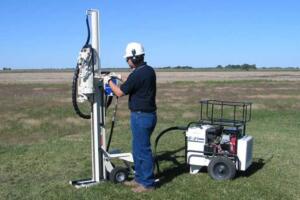VERTEX’s Remediation Division often receives requests from clients to complete soil and groundwater sampling in a variety of settings, including urban environments. Drilling in cities and densely populated areas presents a unique set of challenges in terms of:
- Encountering tight spaces
- Ensuring the safety of occupants regularly occupying the property being investigated and,
- Minimizing disruption of the site’s business operations.
Below are some best practices when performing environmental drilling in urban areas.
Safety First
Safety is always the primary focus in any work performed by VERTEX, especially when conducting subsurface work in urban areas where subgrade utilities are often present. VERTEX employees undergo regular, focused safety training on how to assess sites for potential interference from utility locations before choosing boring locations, and also complete site-specific Health and Safety Plans for each project. This is intended to not only protect the safety of VERTEX employees and subcontractors but also limit the potential to damage utilities serving your property.
Before conducting any subsurface work, VERTEX contacts all appropriate local and state utility clearance companies so that they can mark their utility locations before conducting work. VERTEX will also contract private utility locating services that utilize equipment such as a Ground-Penetrating Radar (GPR) instrument and/or EM-metal detector to identify and clear proposed boring locations, and boring locations are typically cleared manually to a depth of 5 feet before continuing drilling activities.
Another critical step in conducting utility clearance is cooperating with the site owner, who may have personal knowledge of utility locations or be able to provide utility plans for their property.
Direct Push Technology (DPT)
A common type of drilling equipment utilized in urban areas utilizes Direct Push Technology (DPT). DPT machines advance sampling tools using a percussive hammer and the weight of the vehicle the equipment is mounted on. For environmental soil sampling purposes, the DPT machine vertically “pushes” a hollow metal tube (commonly called a drill rod) containing an acetate liner into the ground surface, and is generally utilized to depths between 20 and 30 feet below ground surface (bgs). Once soil sampling activities are completed, the drill rod can be left in the borehole to facilitate the collection of a temporary groundwater sample.
DPT equipment can be mounted on a variety of vehicles, including pickup trucks, bobcats, and track-mounted vehicles (some small enough to squeeze through a 36” wide door). These drill rigs can operate within enclosed spaces with as little as 15 feet of ceiling height. Drilling contractors can even provide DPT equipment mounted on carts that can be moved by hand into smaller interior spaces, or use a modified jackhammer to advance the sampling equipment. Modern DPT drill rigs also include the ability to turn augers required to install permanent monitoring wells up to 4” in diameter, which removes the need to utilize the much larger drilling rigs needed to complete this work in the past.
Will DPT Drilling Damage My Property?
The drill rod utilized by the DPT drill rig creates a borehole that is a little more than 3” in diameter. The percussive hammer utilized by the DPT equipment can easily punch through asphalt and concrete slabs less than 6” in thickness.
If damage to a concrete surface finish is a concern, the concrete can be cut neatly with a coring machine before drilling activities. Once drilling activities are completed, the asphalt or concrete are easily patched to grade leaving no significant damage. However, interior floor finishings such as vinyl floor tile will need to be repaired in those areas.
DPT Drilling Precautions
When advancing a soil boring using DPT, the specific area occupied by the drill rig will need to be cordoned off by VERTEX and the drilling operator to ensure the safety of regular property occupants, typically using traffic cones, caution tape, or even vehicles. The operation of the DPT drill rig also generates considerable noise, so anyone not wearing hearing protection should stay at least 100 feet away from the drilling location.
While drilling activities are being conducted in a specific area, building occupants will need to vacate the drilling area causing a small disruption. Depending on the depth of the soil boring, the work typically takes around an hour. Once this is completed and the surface finish has been repaired, the drill rig will be moved out of the area to another location. Because specific areas are only occupied by the drill rig for short times, VERTEX can plan the drilling program to avoid areas of a property while businesses are operating and can attempt to develop sampling plans that avoid occupied areas altogether, if possible, so that your business can continue to operate.
How Can VERTEX Help?
VERTEX has developed soil and groundwater sampling plans and conducted environmental drilling oversight since 1995. We understand that even though your property requires environmental investigation, your business must continue to operate.
To learn more about VERTEX’s Environmental Consulting and Remediation services or to speak with an Environmental Expert, call 888.298.5162 or submit an inquiry.
Author
Glenn Maxeiner, PG
Division Manager, Remediation







